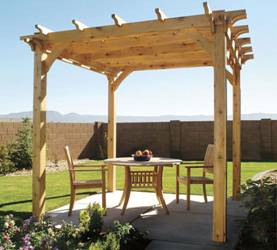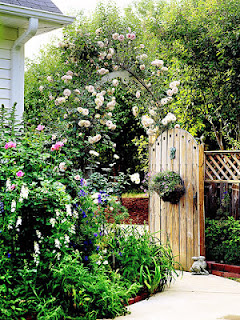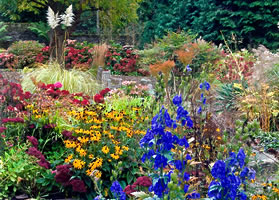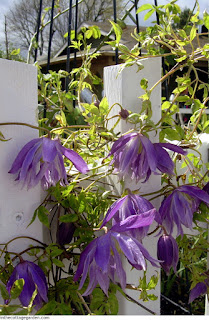Friday 15 March 2013
Sunday 10 March 2013
Plants Care in Summer and Rainy Season
Plants Care in Summer and Rainy Season
Plants are the
priceless gifts of nature. Green color is mostly prescribed by opticians in
order to cure a number of optical problems. Eyesight is sharpened by greenery.
Some people love plants as their
friends and parts of life. There are thousands of reasons for plantation and
protection of plants. Our climate is subtropical;
summer is always severe and harsh. Every
living being is susceptible to its dangerous effects. Plants are also affected to
much extent. Some get wilted due to severe water loss and sunshine, other go
brown and some die off.
There
are two important things to be kept in mind in order to ensure plants safety. First is temperature and other is irrigation. To save plants which cannot resist sunshine
for longer durations they should be covered by green shed or green net. ,,
while fixing the shed it should be kept in mind that it should be somewhat more
towards south-west because sunlight after 2’o clock is inclined at that angle. Potted Plants could also be kept in partial
shade.
The
other most important thing is irrigation. Plants planted in soil should be irrigated twice a day. First
irrigation should be at early at least before 9 ‘O clock, and second irrigation
should be after 4 pm. Do not irrigate plants in full sunshine and noon time.
For potted plants irrigate frequently after 4-5 hours
because evaporation is maximum and media cannot retain moisture for day long. Try
to avoid placing plants under direct sunlight for whole day, place in semi
shade area. . Potted plants cannot tolerate too much temperatures as compared
to earth grown and field crops. Plants with delicate and soft leaves are more
affected as compared to those having hard and leathery leaves.
During summer drought period avoid pruining or limit it to diseased or dead portion as pruining of tree also puts stress on the plants. When a tree is stressed during a drought, sometimes gardeners think it needs to be fertilized. Actually, fertilizers can contain high salt concentrations and cause further harm to the tree.
These are precautionary measures as whole, typically every plant have specific characters and responses to environment. Consult experts for asking requirement of your plants in description.
During summer drought period avoid pruining or limit it to diseased or dead portion as pruining of tree also puts stress on the plants. When a tree is stressed during a drought, sometimes gardeners think it needs to be fertilized. Actually, fertilizers can contain high salt concentrations and cause further harm to the tree.
These are precautionary measures as whole, typically every plant have specific characters and responses to environment. Consult experts for asking requirement of your plants in description.
Horticulture -Prospects in Pakistan
Horticulture is an important field of agriculture. In Netherland they produce 500 Million plants each year.Their economy depends totally almost on Horticulture. The main outcomes of Hortuculture are fruits, vegetables,, flowers and ornamental plants. It is most profitable and fast growing field. Modern concepts of growing all types of plants are being
practiced in developed countries. Some African countries like Ghana are getting
reasonable foreign exchange by the export of cut flower to USA and other
countries of the world.
We have many advantages and positive aspects to adopt and flourish our horticulture business for example fertile lands, inexpensive labor, best climatic conditions and qualified experts of the subject. Lack of entrepreneurship and government interest s are our big problems. Unemployment is growing as a bigger problem with increase in population. This problem could be handled by making policies friendly to farmers, entrepreneurs and other people related to this field. The price hike in food commodities causing frustrations among people could be handled and controlled by increasing our horticultural produce especially fruits and vegetables. Government could start projects with the help of agriculture graduates to cultivate uncultivated and barren lands by installing orchards and commercial vegetables farms, exportable cut flower farms, producing export quality produce.
Orchards could make the climate cool and pleasant. Air pollution could gradually reduced by plants. The beauty and value of property could be enhanced many folds by the installation of orchard on farm lands. Government should provide subsidy and loans for promotion of horticulture along with other agronomic crops. There should be sustainable mechanism and easy procedures for new comers to develop urban horticulture business, nursery farms soil less culture and cold storage houses.
We have many advantages and positive aspects to adopt and flourish our horticulture business for example fertile lands, inexpensive labor, best climatic conditions and qualified experts of the subject. Lack of entrepreneurship and government interest s are our big problems. Unemployment is growing as a bigger problem with increase in population. This problem could be handled by making policies friendly to farmers, entrepreneurs and other people related to this field. The price hike in food commodities causing frustrations among people could be handled and controlled by increasing our horticultural produce especially fruits and vegetables. Government could start projects with the help of agriculture graduates to cultivate uncultivated and barren lands by installing orchards and commercial vegetables farms, exportable cut flower farms, producing export quality produce.
Orchards could make the climate cool and pleasant. Air pollution could gradually reduced by plants. The beauty and value of property could be enhanced many folds by the installation of orchard on farm lands. Government should provide subsidy and loans for promotion of horticulture along with other agronomic crops. There should be sustainable mechanism and easy procedures for new comers to develop urban horticulture business, nursery farms soil less culture and cold storage houses.
Emerging trend of Organic Farming.
Emerging trend of
Organic Farming.
Organic farming is simply farming without
chemicals. It is a system that seeks to exclude the direct or routine use of
synthetic fertilizers, biocides, veterinary drugs, hormones, additives,
preservatives, growth regulators and other agrochemicals. It relies upon crop
rotations, crop residues, livestock manures, cattle dung, composted municipal
garbage, vermin-compost, organic wastes such as rice husk, wheat husk, cotton
lint and mineral bearing rocks i.e. used to feed the soil and supplies the
nutrients required by plants. It is also called green food production.
Health hazards are drastically
increasing day by day due to the use of food commodities accumulating a great
amount of toxins contributed by pesticides and fertilizers. Chemicals
extensively used for commercial vegetables, fruits and cereals production
contains carcinogenic compounds which permeate into the final produce. The
noticeable ill effects of pesticides are respiratory problems, cancers, less
reproductive ability and many more. The conventional farmers use synthetic
pesticides and fertilizers more extensively in order to attain more yield and maximum
benefits irrespective of their ill effects on human health. They have no
concern with the human health. Wild life is diminishing such as the earth worms
have become scarce and the soil seems dead. Sulphure and sulphure-containing
pesticides are destructive for beneficial insects and arthropods. Go organic
for a genuine, cost-effective, healthier and environmentally safer future
The
organic food on the whole is nutrition and meets anatomical and physiological
requirements of human. It also helps in interaction of food clean like
production, processing, packaging and trading within the environment and the
social structures. For keeping good health it becomes necessary to avoid use of
such vegetables. Organic food has a better taste and a great variety. It
contains on average 50 percent more vitamins, minerals, enzymes and other micro
nutrients than intensively farmed produce.
Organic cultivation replenishes and
maintains long term soil fertility by reducing nitrate leaching. Increasing and
improving wild life habitant. Naturally occurring microorganisms in soil play
an important role in nitrogen cycle and decrease pathogenic fungus and
bacteria. It encourages the use of natural and renewable recourses. It is to
ensure healthy farm livestock. It provides more predicable economic returns. It
boosts farm income and promotes sustainability. It maintains the genetic
diversity of agricultural ecosystems. It ensures sustainable and healthy
conditions for future generations. In world the total area under organic farming was 31million hectares and there were total 633891 farms managed organically round the world. (By the FiBL Survey 2007). While in Pakistan at present there are 20'310 hectares under organic farming and 28 farms managed organically. (By the FiBL Survey 2005-07). The studies show that 30.4 million hectares are currently certified according to organic standards. It is commercially practiced in 120 countries. The global market for organic products reached a value of over 40 billion US Dollars.
As Organic farmers are not allowed
to use synthetic pesticides or fertilizers therefore use of such toxic
chemicals should be completely avoided. Good agricultural practices are needed
to be carried out. The integrated pest management system is to be adopted.
Weeds managed manually or mechanically. Green manuring has a positive influence
on physical and chemical properties of soil. It maintains organic matter status
of soil and increases its water holding capacity .Soil microbial population is
also multiplied and soil aeration is improved. The organic wastes are also
recycled.
The dawn of third millennium bears immense
concerns about potentially environmental hazards throughout the world. Public
apathy and official indifferences on environment protection is not a secret.
There is a dire need to decimate polluted environment. Organic farms are better
than conventional farms at sustaining diverse ecosystems, i.e. population of
plants and animals creating environment friendly atmosphere. Organic farming
helps to minimize the greenhouse effect and global warming through its ability
to sequester carbon in the soil. Organic farms support nature, whereas,
intensive conventional farming has led to dramatic erosion of soil, fall of
wild birds, destruction of ancient hedgerows, and extinction of some species
like butterflies, frogs, grass snakes and wild mammals.
The basic standards for organic
production are published by the International Federation of Organic Agriculture
Movements IFOAM. These IFOAM basic standards define how organic products are
grown produced processed and handled. The organic farmers have to meet these
standards. Certification, accreditation and labeling the produce as ‘organic’
must be made by the certified and registered agencies. In Pakistan
most of the Organic Farms
are certified by Control Union Certifications Zwolle, the Netherlands for
organic production methods and USDA-NOP standards.
The mostly grown commodities are
organic rice, organic cotton, organic wheat, organic sugar, organic sucrose,
Organic Kinno fruit and juice concentrate, and Organic Mango fruit and pulp and
seasonal fresh vegetables.
Prospects in Pakistan
Pakistan
has a great potential for organic farming by delineating million of acres of
most fertile and productive land. Progressive farmers community is destined
turning towards organic cultivation. The area under organic farming will
increase as public awareness and health consciousness are boosted up by the media.
Organic farming here in Pakistan has many challenges to conduct. Organically
produced commodities are relatively more perishable.
The
reasons for slow progress of organic farming include lack of awareness among
people about its benefits. Export of organic produce is at very limited level.
There is also lack of inspection and certification agencies. Government price
policies and monopolies on market of agriculture produce, causing low
agricultural income.
The
organic food market is growing rapidly in the entire world. Various alternative
organic standards are also emerging. Some are also implementing new approaches
to defining and buying food. Farmers have to reap market premium for certified production.
The organic commodities will have high prices in domestic as well as in super
markets. Hence the economy will grow with a potential to alleviate poverty. Organic
food is also often linked with the fair trade movement, based on the principle
that social and environmental sustainability are inextricably interdependent. Initiatives
should be taken to organize marketing of organic food through creation of
awareness and establishment of markets. Pakistan has large area which has used
minimal pesticides and chemicals, where potential for conversion exists. It is
envisaged that a reasonable percentage of production shall be organic in coming
five years. The major organic food markets for Pakistan are Europe, the USA,
Japan and Middle East. There is bright future which indicates impressive
opportunities of different organic food products by Pakistan to export. Organic
farming is also compulsory in order to withstand WTO standards to increase
export of our agricultural produce. Future
prospects show proper utilization of recourses and profitable use of farm wastes.
Soil water and air pollution would be reduced. Organic farming will provide an
avocation to the land less laborers. Its objective are to develop low capital
less labor intensive, high yielding, better quality and healthy organic
farming. Reducing the cost of production to minimum to achieve self-sufficiency
in all inputs. It is recognized as a long-term solution to the problem caused
by nitrate pollution. Organic agriculture in the beginnings shows lower yields
than conventional cropping but as its input are lower than conventional
agriculture and labor in Pakistan is cheap, in long when organic agricultural
methods have improved soil characteristics, soil fauna and established worm
activity and large production of vermicasts, the yields will surpass the
conventional methods.
It
is concluded to be a very vast and diversified field. There is growing demand
of organic food products throughout the world. The researches and developments
on national level are strictly needed to be made. The government should provide
subsidy, financial and technical support to the farmers for organic crops
cultivation. It is needed to shift our agriculture trends towards saving the
nature. This will give us safe agricultural products and the power we use to
dispose off our solid wastes. It is right of our next generation that if we
can’t give them a better environment, we have no right to worsen it any more.
Saturday 9 March 2013
Importance of Botanical Gardens
Importance
of Botanical Gardens
Botanical gardens are the basic resource a nation who may
have. Plants have been friends of all living beings since ancient of times. They
had served the masses in providing the shelter food clothes and other needs of
life.
Biodiversity is essential for an ecosystem to ensure its
sustainability. Many valuable and priceless species are endagerd and many are
extincted that have brought many losses to human beings and other animals.
Fragrant Plants
Grow beautiful fragrant and aromatic plants and make the
environment fragrant
Among the many benefits of plants fragrance is a big
advantage. Fragrance in plants is due to the presence of chemical compounds in
flowers and leaves of plants which spreads in the air lik perfumes and makes it
fragrant. There are many types of plants some of them are important for their fragrance.
You can easily grow them in your lawn, garden and enjoy their fragrance. Some
of the fragrant plants give fragrance to vast areas in environment/atmosphere. Fragrance
in air helps the nerves to relax decrease frustration brings drastic change to
mood and health. Remedies the polluted environment and helps to avoid the air
being pungent and unhealthy. Therefore its dire need to plant more and more
fragrant plants which are not only important for us but also for our environment
society and collectively for our wellbeing prosperity beloved country
Gul e cheen has good fragrance spreads its fragrance far
off. You can enjoy it from distance too. Similarly murwa has also good and wide
spreading fragrance. Other than these there are Roses, Jasmine, Lady of Night,
Motia, Mushk e been, Honey suckle ,Niaz boo, Alaichi, and other plants.
Location selection is important for plantation of these
plants, Most of them are shrub and some are climbers, vine shaped. They can be
easily planted beautifully at entrance, among poles, columns, balconies, window
boxes, near patios, sitting areas, etc, important to note is that fragrant
plants should be planted in the form of groups so that their fragrance and color
effect could easily felt.
Decorate your home with beautiful indoor plants.
Decorate your home with beautiful indoor plants.
Muhammad Imran Khan
Suggested titles
- Decorate your living area with plants
- Interior decoration with plants
- Home’s interior decoration with plants
- Interior plantscaping
Importance
1
Plants are the lungs
of nature. Nature beautifies itself by plants. Here is an outstanding process
in which plants absorb environmental carbon dioxide and release oxygen which
everyone requires for breathing. Oxygen is absorbed by our lungs, mixed into
blood and provides energy to the whole body. Men living in oxygen rich areas
are healthier then those in oxygen deficient places. Suffocation is the
uneasiness felt by us due to lower concentration of oxygen in air. You can get
healthy life and pleasant feelings simply by taking more oxygen which is
provided by plants.Plants in green color and broad leaves provide more oxygen
as compared to those with pigmented and narrow leaves.
2
With the absorption of CO2 plants also absorb dust, noise, and other
harmful gasses etc.
Plants reduce the chemicals in the air. Aglaonema,
Aloe, Aphelandra, Asplenium, Chamaedorea, Dracaena, Ficus benjamina, Gerbera,
Hedera, Philodendron, Sanseveria, and Spathiphyllum all reduce things like
benzol, TCE, and formaldehyde.
3
The green color of plants have medicinally proved the best
results on vision or eyesight. Electronic gadgets and ultra modern lifestyles
have created some risks like uneasiness, sadness bored ness. These problems
could be easily cured by planting attractive plants on different places either
indoor or outdoor.
4
Another extremely important
function of plants is the environmental regulation. How does plants regulate
the environment is simply by transpiration. Transpiration is the evaporation of
water from the leaves of plants. Thus they maintain the humidity in air, keep
the temperature down and put a soothing effect on body and sensations. The more
evaporation of water from plant leaves means more chances of rainfall and
coolness of climate. This way the scientists proved that plants lower the temperature
of the area 3-4 ºC compared to the area without plants .
Plants shield house from heat robbing winds and lessen electricity heating and cooling bills.
5
Aesthetically plants are also
very much important. The beautiful for, size, arrangement of leaves, braches
and stem beauty of plants attract the viewers a lot. The mind is get freshed
when we see these beautiful natural gifts.
6
Indoor gardening gives immense pleasure, thrill, bring intimate and
natural association with plants, a matter of over joy, adds charm to the
architectural beauty, and complements the interior settings. It is a useful and
absorbing hobby. A source of exercising gardening adventures and brings
permanence in the house. It’s the best way to overcome troublesome loneliness. Living
and innocent friends like plants give the pleasure and concept of life to grow,
attract, and benefit mankind.
Plants soften the harshness of buildings, walls, and rough
textured constructions.
If hot colors used as paint that can be cooled by plants
giving hot and cool effect simultaneously. Thus adding interest to be in such
areas.
The shining and pigmented brood and narrow leaved plants
give a waving and eye catching feeling.
Arrangement
Proper arrangement and placement of different adds value to
each plants and the whole landscapes.Plants bring movement and life to every
room in your home. However, you will be pleased by the whole picture only
if there is harmony in the arrangement and color of the plants you have chosen.
Once you have learned how to take these things into account Select
plants according to your nature, taste , and imagination plan.
The larger the room you are
working with, the bigger and more numerous the plants can be. A single small
green plant looks lost in a large empty space. Several flowering plants
in a basket or arranged in small pots on the same table can serve as a
beautifully colorful accent to a room. Treelike plants have great
importance in the sense of decorating. Large-leafed species like
dracaena, philodendron or the banyan tree (Ficus benghalensis) can really fill
up a sparsely furnished room or entrance hall.
In a small room, large plants are oppressive and take up way
too much space. To get the best effect, you should choose mid-size or
small plants with large delicate leaves. Put the plants where they are
going to be visible. Don’t put too many plants in a small space or it
will get too crowded and your individual plants won’t make their full impact on
the room.
Plants always look best against simple backgrounds. If they
have large foliage they should be placed in front of wallpaper with a small
pattern. Large patterned wallpaper calls out for filigreed leaves or ferns.
Even the Umbrella (Cyperus) would work for that. Wood-paneled walls like
climbing plants arranged on a wood or bamboo support. These also look great by
brightly painted walls.
Make sure your decorative scheme takes into account the way
light enters your room. If you put the plants in front of a bright,
sunny wall, their shadows can create interesting and unusual patterns on the
wall or ceiling or even plain carpeting.
Make sure the colors of leaves and flowers you choose don’t
clash with your decor. You don’t want to take expensive furnishings and
wall coverings and reduce them by the wrong colored flowers in your pots. Place
your plants by each other where they can compliment each other. Put
larger plants in the background of smaller plant groupings. A little bit
of ivy (Hedera helix) growing over the edge of a pretty bowl looks nicely
casual.
Different furnishing styles take on different plants.
It’s important that you put the right plants into your decor to “complete the
picture”. Yucca, Schefflera and rubber trees (Ficus) fit in well with
wooden furniture. Flowering plants look great with a country style
decor. Bulbs and primulas in the spring and special geraniums in the
summer work great here. If you like the straight or gently curved forms
of steel, glass, marble and varnished wood, things like the snake plant
Sansevieria , Monstera , Dracaena and Guzmania work wonderfully.
Plants with simple gently curving lines work in art nouveau
and art deco settings. The flamingo flower (Anthurium) and peace lily
(Spathphyllum) are perfect. Furniture made of bamboo and rattan and
oriental style shapes are perfect for exotic hanging plants like string of
pearls (Senecio royleyanus) or wax plant (Hoya). Traditional English or
French styles go well with bushy, vigorously flowering plants like the
cyclamen, carnellias, gloxinias (Sinningia hybrids) or begonias.
All you have to do is play around creatively with plants and
figure out what enhances your style. It’s really not that hard.
Once you start placing plants, you will know what goes with what and what
doesn’t.
Ugly features like bad corners and unpleasant design
mistakes which harm certain areas view , can be corrected simply ny plants,
hanging baskets, walll side containers, above wall pots, base pots, can be used
at such places.
Innovative ideas and collections of varying design planting
pots which may be of different colours, textures, shapes, and sizes could be
helpful. There are many characers and habits of different plants needed to be
exploited, observed and broad range of of characters of plants. You can choose
a plant of any character which you like the most.
Colour
Colour changes the perception sof space . colours
dramatically alter the mood as they are closely linked to mind and emotions .
cool colours have the ability to feel us relaxed while warm colurs stimulate
muscular activity,lend cosy warmth to area and excites us as we all need to
chill.
Plants with white leaves and flowers bright up the dark and
shady corners.
Cut fronds ( cul foliage and branches with flowers and
fruits) and leaves of pithosporum Hedera, Phomium and many more ,Asparagus,
Ferns, Aralias, Aspdistra those often included in bouquets and can also be
placed in state of the art vases , helping in multiple functions.
Agave victorial for indoor display.
Maintenance
Most plants have a natural shine and do not need additional
luster if kept clean. If a polish is to be used never use it on the underside
of the leaves as it clogs the stomata underneath.
Keep the plants in trim by cutting the old dead leaves , the
yellow lower leaves, and any brown tips.
Changing the arrangement of plants and places needs care
regarding the plants requirement of food, sunlight and humidity.
Consult plant experts to check and know suitable place for
each specie or variety you have and you should be well aware of feeding and
other requirements of plants.
This is important because some plants are hardy which can
bear worse conditions while others so tender and delicate that they cannot bear
minute stresses.
Sapmle plants
Auracaria, Asparagus, Beaucarnia, Begonia rex, Calathium,
Cholorophytum, Coroton, Coleus, Dracaena, Ficus, Syngonium, Tradescantia, Senseveria,
Areas
Homes, offices, shopes, banks, hotels, restaurants, clubs
and hospitals, universities, colleges and schools.
Harmonize home building .
Friday 1 March 2013
All About Composting
All About Composting
Composting is no doubt a worthdoing activity as for as farming or gardening is concerned. Compost is a decomposed organic matter. Organic matter is necessary for plants to grow well and a key to obtain excellent produce. Organic matter provides minerals to the roots, helps to retain soil moisture, good for soil porosity which provoids oxygen to roots. I have come to know many stories of composting by many friends in gardening. All they found it a good and excellent job.
Composting is not a difficult job. It is quite easy. Make a dig in your nearby place where smell may not be a big issue. Put all your decomposeable household waste, leaves, vegetables and fruit covers etc in that dig and cover the hole with mud/soil.Left it for some months after 3-4 months you will find a good compost ready for filling your pots, flower bed and other plants.
Composting is no doubt a worthdoing activity as for as farming or gardening is concerned. Compost is a decomposed organic matter. Organic matter is necessary for plants to grow well and a key to obtain excellent produce. Organic matter provides minerals to the roots, helps to retain soil moisture, good for soil porosity which provoids oxygen to roots. I have come to know many stories of composting by many friends in gardening. All they found it a good and excellent job.
Composting is not a difficult job. It is quite easy. Make a dig in your nearby place where smell may not be a big issue. Put all your decomposeable household waste, leaves, vegetables and fruit covers etc in that dig and cover the hole with mud/soil.Left it for some months after 3-4 months you will find a good compost ready for filling your pots, flower bed and other plants.
The raw materials used are mixed plant residues, animal
dung and urine, earth, wood ash and water. All organic material wastes
available on a farm such as weeds, stalks, stems, fallen leaves, prunings,
chaff, fodder leftovers and so on, are collected and stacked in a pile. Hard
woody material like cotton or pigeon pea stalks and stubble are first spread on
the farm road and crushed under vehicles such as tractors or bullock carts
before being piled. Such hard materials should in any case not exceed ten percent
of the total plant residues. Green materials, which are soft and succulent, are
allowed to wilt for two to three days to remove excess moisture before
stacking; they tend to pack closely if they are stacked in the fresh state. The
mixture of different kinds of organic material residues ensures a more
efficient decomposition. While stacking, each type of material is spread in
layers about 15 centimetres thick until the heap is about one and a half metres
high. The heap is then cut into vertical slices and about 20-25 kilograms are
put under the feet of cattle in the shed as bedding for the night. The next
morning the bedding, along with the dung and urine and urine-earth, is taken to
the pits where the composting is to be done.
The
site selected for the compost pit should be at high level so that no rainwater
gets
in
during the monsoon season; it should be near to the cattle shed and a water
source. A
temporary
shed may be constructed over it to protect the compost from heavy rainfall. The
pit should be about 1 m deep, 1.5-2 m wide and of any suitable length.
The
material brought from the cattle shed is spread evenly in the pit in layers of
10-15
cm.
On each layer is spread a slurry made with 4.5 kg dung, 3.5 kg urine-earth and
4.5 kg of inoculum taken from a 15 day-old composting pit. Sufficient quantity
of water is sprinkled over the material in the pit to wet it. The pit is filled
in this way, layer by layer, and it should not take longer than one week to
fill. Care should be taken to avoid compacting the material in any way.
Turning:
The
material is turned three times during the whole period of composting; the first
time
15 days after filling the pit, the second after another 15 days and the third
after another month. At each turning, the material is mixed thoroughly,
moistened with water and replaced
in the pit.
The pit method
Generally,
composting is carried out in a corner of a field and in a circular or
rectangular
pit. Rice straw, animal dung (usually pig), aquatic weeds or green manure crops
are used and often silt pumped from river beds is mixed with the crop residues.
The pits are filled layer by layer, each layer being 15 cm thick. Usually, the
first layer is of a green manure crop or water hyacinth, the second layer is a
straw mixture and the third layer is of animal dung. These layers are
alternated until the pit is full, when a top layer of mud is added; a water
layer of about 4 cm depth is maintained on the surface to create anaerobic
conditions which help to reduce losses of nitrogen. Approximate quantities of
the different residues in tons per pit are: river silt 7.5, rice straw 0.15,
animal dung 1.0, aquatic plants or green manure
0.75
and superphosphate 0.02. Three turnings are given in all, the first one month
after filling the pit and, at this time, the superphosphate is added and thoroughly
mixed in. Water is added as necessary. The second turning is done after another
month and the third two weeks later. The material is allowed to decompose for
three months and produces about eight tons of
compost per pit.
Subscribe to:
Posts (Atom)










.jpg)




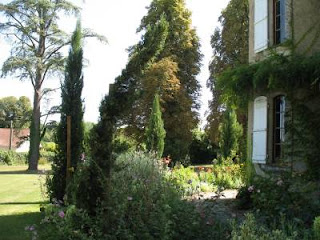








.jpg)




